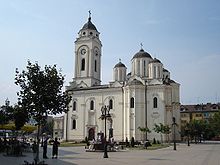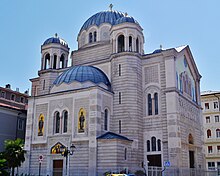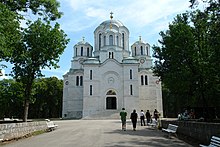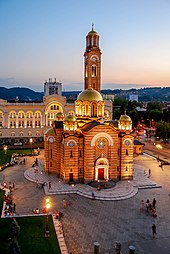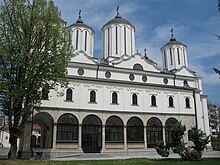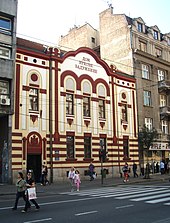
The Church of Saint Sava is a Serbian Orthodox church which sits on the Vračar plateau in Belgrade, Serbia. It was planned as the bishopric seat and main cathedral of the Serbian Orthodox Church. The church is dedicated to Saint Sava, the founder of the Serbian Orthodox Church and an important figure in medieval Serbia. It is built on the presumed location of St. Sava's grave. His coffin had been moved from Mileševa Monastery to Belgrade. The coffin was placed on a pyre and burnt in 1595 by Ottoman Grand Vizier Sinan Pasha. Bogdan Nestorović and Aleksandar Deroko were finally chosen to be the architects in 1932 after a second revised competition in 1926–27. This sudden decision instigated an important debate in interwar Yugoslavia which centered around the temple's size, design and symbolic national function. This was accompanied by a sizeable increase in the base area of the ambitiously conceived project. The new design departed from the competition guidelines issued in 1926, and was to replicate the dimensions and architecture of Hagia Sophia.

Neo-Byzantine architecture was a revival movement, most frequently seen in religious, institutional and public buildings. It incorporates elements of the Byzantine style associated with Eastern and Orthodox Christian architecture dating from the 5th through 11th centuries, notably that of Constantinople and the Exarchate of Ravenna.

Aleksandar Deroko was a Serbian architect, artist, and author. He was a professor of the Belgrade University and a member of the Serbian Academy of Sciences and Arts.
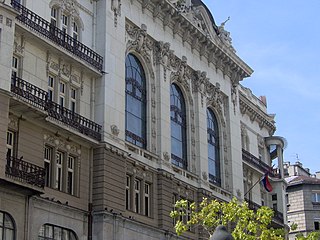
The Serbian Academy of Sciences and Arts is a national academy and the most prominent academic institution in Serbia, founded in 1841 as Society of Serbian Letters.
Odbojkaški klub Partizan commonly known as OK Partizan, is a volleyball club from Belgrade, Serbia. OK Partizan is a part of JSD Partizan. The club formed in 1946. In its history, Partizan won 12 national championships, 9 cups and 1 supercup. The women club formed in 1950. In its history, it won 9 national championships, 2 cups and 2 supercups. The female team ceased to exist in 1972. but was re-established in 2016. One of the best volleyball players in the world, Ivan Miljković, started his professional career with OK Partizan.

The architecture of Serbia has a long, rich and diverse history. Some of the major European style from Roman to Postmodern are demonstrated, including renowned examples of Raška, Serbo-Byzantine with its revival, Morava, Baroque, Classical and Modern architecture, with prime examples in Brutalism and Streamline Moderne.

The New Cemetery is a cemetery complex in Belgrade, Serbia, with a distinct history. It is located in Ruzveltova street in Zvezdara municipality. The cemetery was built in 1886 as the third Christian cemetery in Belgrade and as the first architecturally and urbanistically planned cemetery in Serbia.

Architecture of Belgrade is the architecture and styles developed in Belgrade, Serbia. Belgrade has wildly varying architecture, from the centre of Zemun, typical of a Central European town, to the more modern architecture and spacious layout of New Belgrade. The oldest architecture is found in Kalemegdan park. Outside of Kalemegdan, the oldest buildings date only from 19th century, due to its geographic position and frequent wars and destructions. The oldest public structure in Belgrade is a nondescript Turkish türbe, while the oldest house is a modest clay house on Dorcol, the House at 10 Cara Dušana Street from 1727.
The End of the Obrenović Dynasty is а Serbian historical drama television miniseries which depicts events that led to the May Overthrow and assassination of the last Serbian king from the Obrenović dynasty, Alexander, and his close family.
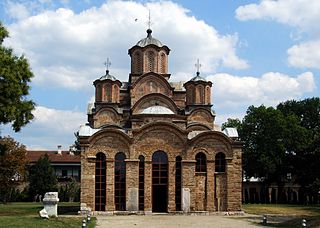
The Serbo-Byzantine architectural style or Vardar architectural school, is an ecclesiastical architectural style that flourished in the Serbian Late Middle Ages, during the reign of the Nemanjić dynasty. It was developed through fusing contemporary Byzantine architecture and the Raška architectural school to form a new style; by the mid-14th century the Serbian state had expanded to include southern Macedonia, Epirus and Thessaly up to the Aegean Sea. On these new territories Serbian art was even more influenced by the Byzantine art tradition. The architectural school was also promoted as a counter to the dominance of Western styles such as Neo-Baroque.
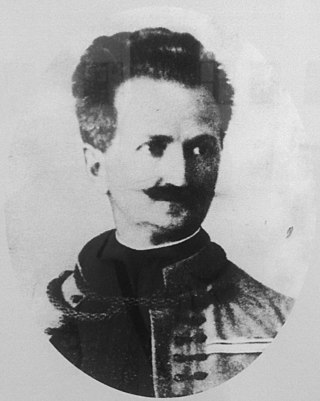
Momir Korunović, was a Serbian architect best-known for his projects built in Serbo-Byzantine Revival. He was sometimes called the Serbian Gaudi. Although he designed some of the most beautiful buildings in Belgrade and was the leading architect of sacred buildings in Yugoslavia between the two world wars, today he is insufficiently known to the general public. Many of his works were destroyed or substantially altered during World War II and the period of communist dictatorship.
Dragutin Đorđević was a Serbian architect and university professor who worked during the last decade of the Belle Époque and the interwar period. He was a corresponding member of the Royal Academy of Arts and Sciences from 16 February 1920.. His work is characteristic of the academic art and eclectic styles in Serbia.
Branko Tanazević was one of the most famous Serbian architects of the Art Nouveau and Serbo-Byzantine Revival, also known as the Serbian national style, which he successfully combined in his works. He graduated from two faculties: the Technical Faculty in Belgrade, the Department of Mechanical Engineering and Architecture in Munich.

Đura Bajalović also spelled Djura Bajalović was one of the leading Belgrade architects of art nouveau in Serbian architecture at the turn of the 19th century. He was the younger brother of Petar Bajalović, also an architect and university professor.
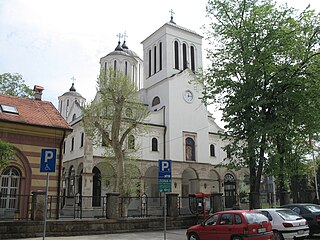
The Holy Trinity Cathedral is the seat of Eparchy of Niš. After the Church of St. Sava and the Church of St. Mark in Belgrade, the Cathedral Church in Niš is the largest in Serbia.

